Rules for servicing a septic tank in winter: cleaning and maintenance
Any local wastewater treatment equipment has to be serviced from time to time. In most cases, the general rules for preventive maintenance and VOC cleaning are applied. And most of them can be done independently.
The only difficult moment is the maintenance of the septic tank in the winter in the cold. After all, not every model of autonomous sewage is generally adapted to work in the winter.
In this article, we will tell you how to service a septic tank in the winter season, and also provide valuable recommendations on the prevention of siltation of treatment facilities.
The content of the article:
Reasons and terms of service of septic tanks
All local treatment facilities are subject to regular cleaning and inspection. They may be aerobic or anaerobicbut you still need to check and maintain them. The terms of maintenance and pumping out of silt deposits for each model of a septic tank are set by the manufacturer. But much here depends on the capacity of the storage capacity and the volume of effluents entering it.
At a minimum, the health checks of all internal systems in VOCs are recommended in the spring and fall. The accumulated sludge should also be pumped out twice a year. But if the intensity of use of the septic tank is high, then it will be necessary to call the sewer more often.
According to manufacturers, aerobic autonomous sewers require less frequent pumping of silt sediment than anaerobic counterparts. However, the volume of effluents and their composition play an important role here. Residents of private homes often wash not only organic food debris, but also solid non-degradable materials and objects together with water in sinks and toilets.
Another problem is the discharge of chlorine-containing and highly acidic liquids into the septic tank. They destroy the microflora of activated sludge. The number of microorganisms decreases sharply, the organic matter in the effluent is not processed, but only accumulates in the metatank. In this case, VOC filling is much faster, so cleaning has to be done more often.
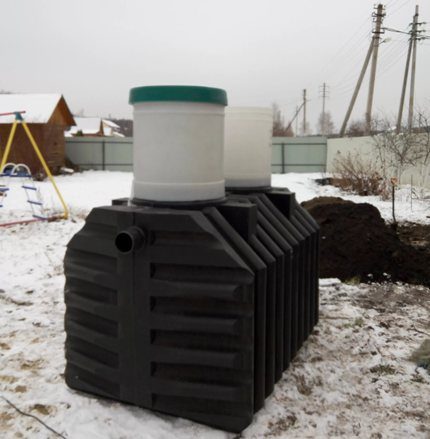
Maintenance regulations for household VOCs in winter
Each septic tank is accompanied by a passport with detailed rules for operation and preventive maintenance. Only compliance with these standards guarantees the correct operation of the entire treatment system.

Maintenance of an autonomous sewage system in winter is associated with a number of problems. And the main one is the low air temperature outside. The septic tank after installation is completely buried in the ground, only the lid remains on top.
Usually it is additionally insulated with thermal insulation materials and covered with a layer of soil up to a meter thick.
If the septic tank is installed exactly according to the rules below the level of soil freezing, then inside it throughout the year the temperature does not drop to minus marks. Earth at depths below the bottom of the septic tank itself freezes only in very cold regions and in severe frosts.
Plus, bacteria that process organics, as a result of their life, create a considerable amount of heat.
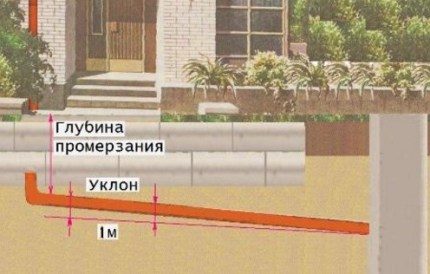
Many septic tank models are designed for operation at outdoor temperatures up to minus 10 ° С. In such conditions, they work without problems in the winter and are subject to maintenance. With more severe frosts, all preventive measures and cleaning should be postponed for several weeks until warming.
Opening the sump hatch in severe frost will lead to a sharp cooling and freezing of water inside, which will inevitably put the septic tank out of order.
Rules and maintenance process
The main measure during the maintenance of the septic tank is the removal of excess sediment. For autonomous sewage to work optimally and efficiently, the volume of sludge in it must be at the level of 15-30% of the metatank cubic capacity.
If there is less of it, then microorganisms for complete wastewater treatment will be too few. And if there is more, then there will be too little space for new waters.
To determine the volume of accumulated sludge on your own, it is necessary to stop the septic tank and scoop up a liquid from it with a two-liter can. As sediment settles in this water tank, sediment precipitates at its bottom. If in the end it turned out to be more than a third of the volume of the can, then the metatanks should be cleaned.
With an excessive content of activated sludge, it begins to thicken, which gradually leads to a decrease in the efficiency of VOCs. Excess sediment must be removed. And it doesn’t matter here - summer at this moment is outside or winter. If the septic tank is needed in working condition, then it will have to be cleaned regularly.
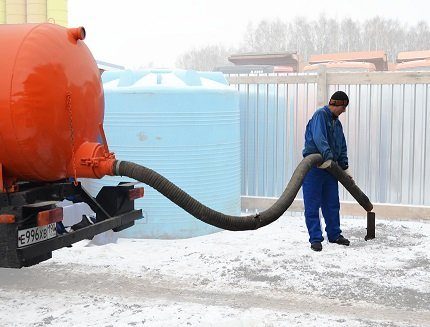
Removes excess waste sludge for help fecal pump. You can do this yourself by pumping the processed sludge from the septic sump into the compost pit for fertilizers, or by shifting this procedure onto the shoulders of the sewage system.
Undecomposed organic matter and inorganic sediment must also be removed from the septic tank. In addition, during its maintenance with clean water, internal pumps, nozzles and elements of the aeration installation are cleaned.
A full range of VOC cleaning activities includes:
- visual determination of the degree of contamination of the station;
- washing the chambers and equipment of the septic tank from accumulated sludge;
- purification of clean water filters and compressor technology;
- extraction from the inside of all solid and not having time to decompose remains;
- flushing with pipe and hoses inside the unit;
- disinfection of a treatment plant;
- replacement of membranes in the compressor;
- the addition of bioactivators (with too few microorganisms in the metatank).
At the end of the cleaning, the entire complex of equipment is checked for operability and correct operation. And then the septic tank is again filled with water for 80–85% of the total volume.
The manhole cover and its fastenings are also inspected. If there is a breakdown, then they will have to be fixed. It does not hurt to check the correctness of the automation settings, with which all processes in the septic tank are controlled.
Pumping wastewater between the sections of the sump, aeration and mixing of the water should be carried out according to the technology developed by the VOC manufacturer and the program.
Features of the septic tank in cold weather
If the equipment is chosen correctly and the sewage system is designed according to the rules, then the septic tank will work properly even at low street temperatures. It just cannot be opened in severe frosts so that the water inside does not freeze from the cold.
Absorbing organic matter in drains, microorganisms generate heat. If the tank is closed, then freezing and failure does not threaten it by definition. Even with simple VOCs, the water inside does not cool below + 3-5 ° C. And when the effluent arrives, the temperature rises altogether to 10–30 ° С.
Under such conditions, bacteria in activated sludge feel excellent and continue to process the organic matter that has arrived in the metatank.
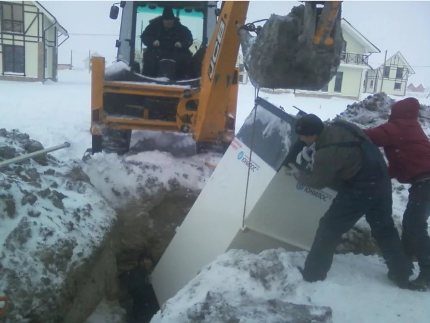
Builders are ready to put septic tanks on personal plots all year round. Winter does not interfere with the installation work. The downside of the winter installation is only one - the higher complexity of digging a pit in the ground under the bacterial wastewater treatment station from a private house.
Among the advantages of installing a septic tank in the cold are:
- The presence of a large number of free teams of installers.
- Reduced groundwater level.
- The ability to install VOCs in a pit dug in floating or crumbling soil.
Technology winter septic tank installation no different from summer. And this applies not only to installation, but also to commissioning and subsequent operation. In winter, the septic tank operates in normal operating mode.
Only in the northern regions will it and the sewer pipe from the house need to be additionally insulated, and how to do this, read in this stuff. And with especially severe frosts, you should forget about the opening of technological hatches, so that the cold could not penetrate into the sump.
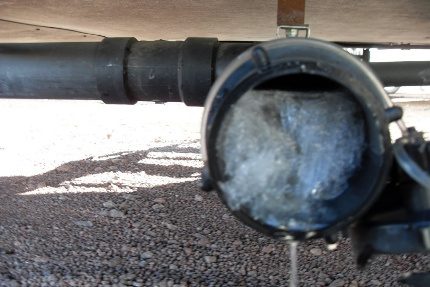
The main weak point in the septic tank in winter is the sewer pipe from it to the house. It is she who most often freezes in the cold. And then the drains simply can not get from the cottage to the treatment station. To defrost the pipeline, pour hot water into it.
But a similar method can only help with small ice caps. In other cases, it is better to entrust an experienced plumber to restore the septic tank to working.
Prevention of clogging and siltation
To with autonomous sewer There were no problems in the winter, the following simple rules should be observed:
- Do not rinse plastic bags, synthetic rags, or other inorganic materials into the sewers.
- It is advisable to install filters for rough mechanical treatment of effluents before they enter the septic tank.
- It is necessary to minimize the ingress of liquids containing chlorine, acid and alkali, as well as drugs, bleaches and oil products into the drain.
On the one hand, solid non-biodegradable waste can clog the pipes and systems of the septic tank. On the other hand, there are many liquids that, if spilled into VOCs, will lead to the death of microflora in it. In both cases, the autonomous sewer system will cease to fulfill its functions.
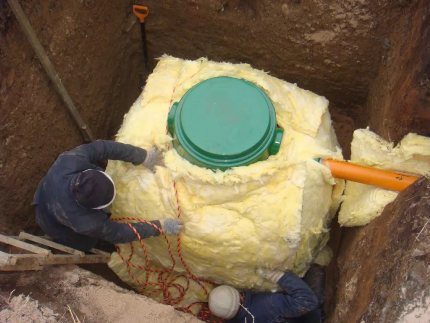
The problems of a septic tank can be associated not only with silting or dying of a colony of bacteria, but also with a narrowing of the pipe drains leading to it due to clogging with garbage. Only help here pipe cleaning mechanical or hydrodynamic method.
Another problem is power outages in aerobic VOCs. Without power, the aerator and water pumps do not work. And this is a direct way to sedimentation and stagnation of silt.
If power was not supplied to the treatment station with aerobes for several hours, then after the appearance of electricity, it is worth checking how it works properly after such a downtime. An unscheduled check in this case will definitely not be superfluous.
What methods can clean the sump?
For pumping sludge from a septic tank, a fecal pump is needed. You will also need a container for carrying sludge to a compost pit or for disposal. Doing VOCs with your own hands is a thankless task. It is often better to call a cesspool machine. A call costs money, but you don’t have to mess with dirt and sewage.
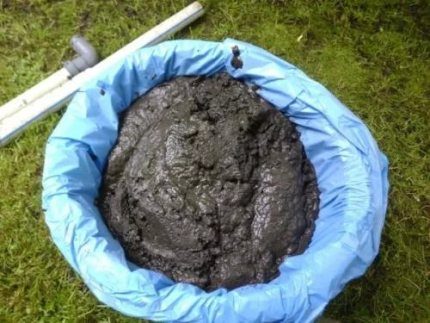
It is easiest to flush the inner walls and equipment using a high pressure washer. To do this dirty job manually is too laborious and time consuming. Yes, and not all sludge deposits can be quickly washed with a rag.
If the septic tank performs the functions of a conventional storage tank for sewage, then drains from it can only be pumped into the barrel of the sewer machine. It is forbidden to use them on a personal plot as fertilizer.
However, during a long break between cleanings, these sewages often turn into a viscous fecal mass, which is difficult to pump out. To liquefy it, a special chemistry based on nitrates, ammonium or formaldehyde will have to be poured into the container.
Conclusions and useful video on the topic
Rules for preparing an autonomous sewage system for winter:
Details of all the nuances of self-cleaning and maintenance of the septic tank "TOPAS":
How to get rid of sludge in the sump in the do-it-yourself way in the winter with your own hands without the call of scavengers:
There are no special difficulties in servicing septic tanks in the winter. Cleaning, preventive measures and sludge pumping are carried out according to technological schemes, which are also used in the summer. This process is quite dirty, like everything related to sewage.
Therefore, it is best to entrust it to the specialists of the slurry company. But you can do all the work yourself, if there is no fear of getting dirty in sewage.
Perhaps your opinion differs from what is stated in the article? Or do you have personal experience in the use and maintenance of septic tanks in the winter season? Please share it with visitors to our site. Leave comments in the block below.

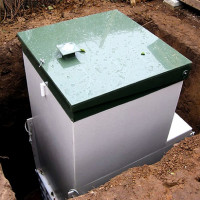 Installation of septic tank “Topas”: do-it-yourself installation + service rules
Installation of septic tank “Topas”: do-it-yourself installation + service rules 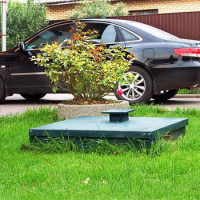 Overview of the septic tank for the cottage “Unilos Astra”: device, service rules, advantages and disadvantages
Overview of the septic tank for the cottage “Unilos Astra”: device, service rules, advantages and disadvantages 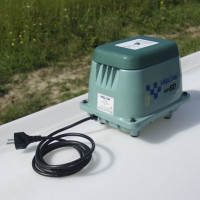 Compressor for septic tank: principle of operation, how to choose + operating rules
Compressor for septic tank: principle of operation, how to choose + operating rules 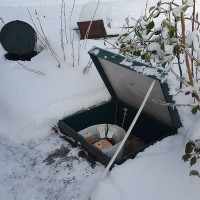 How is the Topop septic tank serviced in winter
How is the Topop septic tank serviced in winter 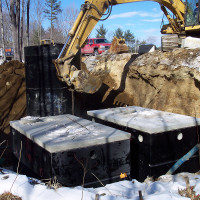 Installing a septic tank in winter: step-by-step instructions and analysis of possible errors
Installing a septic tank in winter: step-by-step instructions and analysis of possible errors 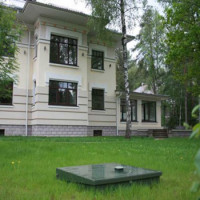 Repair of a septic tank "Topas": features of professional and self-service
Repair of a septic tank "Topas": features of professional and self-service  How much does it cost to connect gas to a private house: the price of organizing gas supply
How much does it cost to connect gas to a private house: the price of organizing gas supply  The best washing machines with dryer: model rating and customer tips
The best washing machines with dryer: model rating and customer tips  What is the color temperature of light and the nuances of choosing the temperature of the lamps to suit your needs
What is the color temperature of light and the nuances of choosing the temperature of the lamps to suit your needs  Replacement of a geyser in an apartment: replacement paperwork + basic norms and requirements
Replacement of a geyser in an apartment: replacement paperwork + basic norms and requirements
We want to make a septic system with filter fields. Will it work normally in winter? Will the water have time to leave or remain in the soil and grow ice? The problem is that in winter the system will be used 3 days a week (Friday and weekends).
In principle, if the entire system is installed correctly and with the calculation of operation in the winter, then no problems should arise. You need to make sure that the tank for the septic tank and the filtration field are buried below the freezing depth of the soil. In this case, the system will maintain the same temperature throughout the year.
If it is problematic to lower the septic tank and the filtering fields to such a depth, then it is necessary to resort to warming. As an inexpensive and practical material, I would recommend the use of extruded foam. This material is not afraid of moisture and strong enough to withstand the load exerted by the soil layer. The same material can be used for insulation of pipes, if necessary.